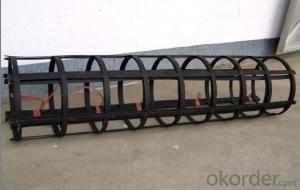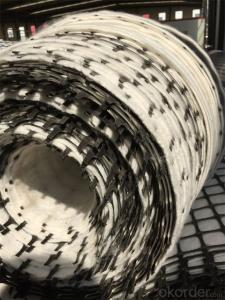Never Run Two-Way Geocells for Erosion Control Geogrid
- Loading Port:
- Qingdao
- Payment Terms:
- TT OR LC
- Min Order Qty:
- 1 m²
- Supply Capability:
- 100000 m²/month
OKorder Service Pledge
OKorder Financial Service
You Might Also Like
Gangsu grille
Products overview:
Shandong yongrun gangsu reinforced geogrid work by gangsu reinforcement with the new technology compound and into, as this product drawing and pressing the surface into a rough figure, the rules laid to fill in in soil have suffered huge resistance to stress and the filled soil and the friction between the whole, limits the foundation soil in the shear, a profile extrusion and uplift, because the stiffness of reinforced cushion is larger, the foundation of the load to spread and more evenly transfer, distribution to lie down on the soft soil, a good way to develop the bearing capacity of the foundation, because the function of the reinforced cushion layer, increase the range of compressible stratum foundation stiffness, be helpful for adjusting deformation of foundation, the use of the reinforced geogrid and the formation of steel model work of the reinforced composite pad to belong to flexible structures, can be very good to absorb the energy of the earthquake, so its seismic performance is good.
Product features:
1, strength, creep, have to adapt to all kinds of environmental soil, and can meet the high road and retaining wall. Use tall
2, can improve the efficiency of the reinforcement embedded lock, bite the load effect, great enhancement the bearing capacity of the foundation, effective constraint of soil lateral displacement of foundation, enhance solid performance.
3, and traditional grille has more strength than large load-carrying capacity and strong, corrosion, prevent ageing, friction coefficient, uniform pore, construction is convenient, service life is long, etc.
4, the more adapted to the deep sea operation, the bank reinforcement, fundamentally solve the other materials do because long stone cage by sea water erosion and cause of low strength and corrosion resistance performance is poor, use short life other technical problems. Product application can be used for highway, railway, embankment and abutment, construction the pavement, dock, bank revetments, prevent flood dike, DAMS and beaches management, freight and slag field, airport, playground, environmental protection construction, soft foundation improvement and retaining wall, slope protection and pavement of inferior civil engineering.
Packing specification:
GSZ30-30-GSZ150-150
- Q: How much is a glass fiber mesh
- Alkali resistant glass fiber mesh cloth big price difference, and the alkali resistant glass fiber mesh quality, high tensile strength, elasticity, tensile strength and elongation between alkali resistant glass fiber mesh elastic limit, so the glass fiber mesh cloth price range is large, with "Jining wellav" WL-0812 series products the price, floating in the price range of $0.32--5
- Q: What is the typical geogrid roll thickness for specific applications?
- The typical geogrid roll thickness for specific applications can vary depending on the specific project requirements and site conditions. However, geogrid rolls typically range from 2 to 10 millimeters in thickness for common applications such as soil stabilization, retaining walls, and road construction.
- Q: What is the distance between the waterproof plate and the top of the tunnel? What are the relevant provisions of this specification?
- Some of the design drawings, the specification seems to be unable to find, which is related to the location of longitudinal flexible drainage pipe
- Q: Are geogrids suitable for reinforcement of railway ballasts?
- Yes, geogrids are suitable for reinforcement of railway ballasts. Geogrids provide effective stabilization and reinforcement to the ballast layer, helping to distribute loads and prevent lateral movement of the track. They improve the overall performance and longevity of the railway infrastructure by reducing settlement, increasing load-bearing capacity, and minimizing track maintenance requirements.
- Q: How do geogrids improve the performance of geosynthetic-reinforced retaining walls?
- Geogrids improve the performance of geosynthetic-reinforced retaining walls by providing additional stability and strength. They work by distributing the lateral forces exerted on the wall more evenly, reducing the chances of wall failure or deformation. Geogrids also enhance the overall load-bearing capacity of the wall, allowing for the construction of taller and more efficient retaining structures.
- Q: Can geogrids be used in reinforced earth bridge piers?
- Yes, geogrids can be used in reinforced earth bridge piers. Geogrids are commonly used as reinforcement materials in soil structures, including bridge piers. They help improve the stability and strength of the soil, enabling it to withstand the loads and pressures exerted on the bridge piers.
- Q: Are geogrids suitable for reinforcement of mechanically stabilized earth slopes?
- Yes, geogrids are suitable for the reinforcement of mechanically stabilized earth slopes. Geogrids provide effective reinforcement by distributing tensile forces and enhancing soil stability. They help to prevent slope failure, control erosion, and increase overall slope strength. Additionally, geogrids are easy to install and have a long lifespan, making them a reliable choice for reinforcement in mechanically stabilized earth slopes.
- Q: What is the typical lifespan of geogrids?
- The typical lifespan of geogrids can vary depending on factors such as the quality of the material, the environmental conditions they are exposed to, and the level of stress they experience. However, geogrids are generally designed to have a lifespan of 20 to 50 years.
- Q: Are geogrids resistant to biodegradation?
- Yes, geogrids are typically resistant to biodegradation.
- Q: What is the market price of the geotechnical grid in 2017?
- (1) the first accurate release of subgrade slope line, in order to ensure the roadbed width of each side of the widened 0.5m, soil drying good leveling by 25T after vibroll pressure two times, then 50T shock pressure of four times, how much is the uneven supply market price? Datong geogrid. Datong geogrid products? Datong geogrid supply market price is how much? Datong geogrid. Datong geogrid products? Datong geogrid supply market price is how much? Datong geogrid. Datong geogrid products? Datong local earthwork grid with artificial coordination. (2) 0.3m thick medium (coarse) sand, artificial with mechanical leveling, 25T vibratory roller static pressure two times. (3) geogrid, geogrid laying bottom surface should be smooth, dense, should generally be tiled, straight, no overlap, no curl, kink, two pieces of geogrid adjacent to lap 0.2m, and along the horizontal Subgrade of geogrid overlap every 1 meters with 8 wire were interspersed in the grid connection, and laying on every 1.5-2m U nail is fixed on the ground.
Send your message to us
Never Run Two-Way Geocells for Erosion Control Geogrid
- Loading Port:
- Qingdao
- Payment Terms:
- TT OR LC
- Min Order Qty:
- 1 m²
- Supply Capability:
- 100000 m²/month
OKorder Service Pledge
OKorder Financial Service
Similar products
Hot products
Hot Searches
Related keywords
























